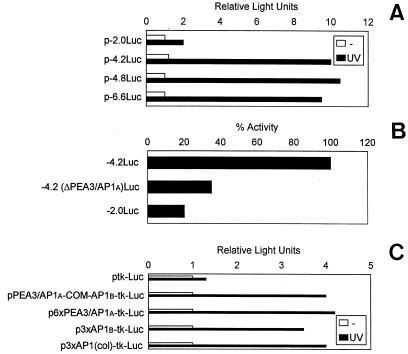FIG. 2.
Transcriptional activity of murine uPA promoter deletion constructs in response to UV. Requirement of an AP1 enhancer element. (A) Transcriptional induction of uPA promoter deletion constructs by UV irradiation. NIH 3T3 cells were transiently transfected with uPA promoter-luciferase constructs of different lengths and then grown in 0.5% FBS for about 16 h before UVC stimulation. Luciferase activity was analyzed at 24 h postirradiation, expressed relative to the activity found with the −2-kb uPA promoter construct (p-2.0Luc) in uninduced cells, and standardized for renilla luciferase activity. All values represented the average of five experiments. The length of the uPA 5′-deletion constructs is indicated below each bar. (B) Requirement of PEA3/AP1A and AP1B sites for uPA promoter induction by UV. NIH 3T3 cells were transiently transfected with different uPA promoter-luciferase constructs lacking either the PEA3/AP1A site only [p-4.2(ΔPEA3/AP1A)Luc] or both the PEA3/AP1A and the AP1B sites (p-2.0Luc) and irradiated as described for panel A. Luciferase activities are represented as a percentage of the activity of the uPA promoter plasmid (p-4.2Luc) containing both AP1 sites in UVC-irradiated cells, which has been given a value of 100%. (C) UV inducibility of multimerized uPA-AP1 sites on heterologous promoters. NIH 3T3 cells were transiently transfected by different reporter constructs containing the complete uPA-AP1 enhancer (pPEA3/AP1A-COM-AP1B), six tandem repeats of the uPA 5′-TRE (p6xPEA3/AP1A), or three tandem copies of the uPA 3′-TRE (p3xAP1B), as well as three copies of the collagenase AP1 element [p3xAP1(col)-tk-Luc], ligated to thymidine kinase-driven luciferase reporter plasmids. Luciferase values were standardized for renilla activities and expressed relative to the activity found with the unresponsive construct ptk-Luc, to which a value of 1.0 has been assigned. All normalized activities represent a minimum of five experiments, showing less than 25% variability.

